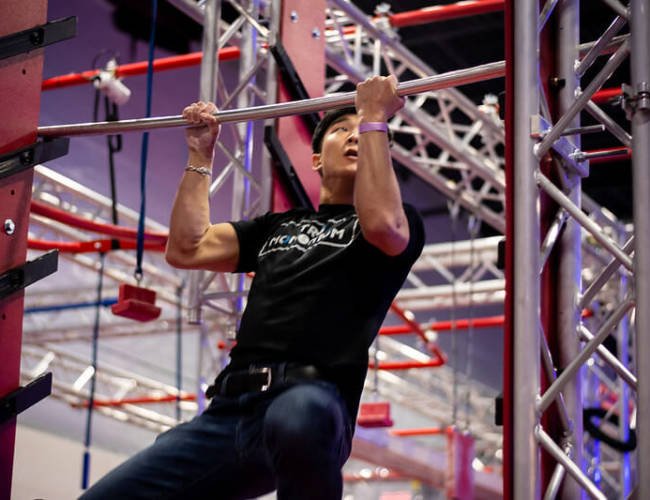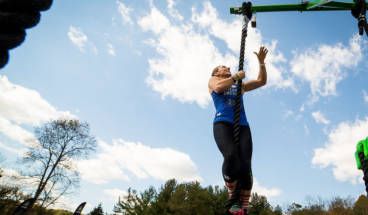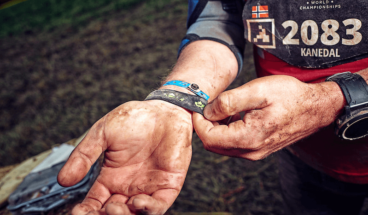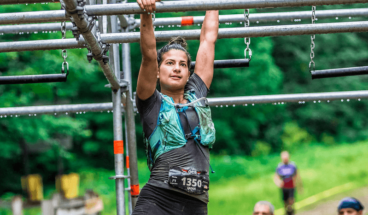
OCR Salmon Ladder Workout & Training Techniques
The dreaded salmon ladder. Long regarded as one of the most challenging obstacles by many racers, it has become easier than ever to prepare for thanks to widespread installation at Ninja training gyms.
With enough practice, the salmon ladder has become something that many of the athletes who focus on short technical races can achieve.
This isn’t to say it’s easy; it’s a technical obstacle requiring a great combination of skill and strength, but the skills you master in this obstacle are also transferable to other obstacles you may come up against.
Check out our salmon ladder workout and technique guide below, to help you succeed.
(Featured image source: Will Baldwin)
What is the Salmon Ladder?
The salmon ladder first appeared on “Sasuke,” the Japanese (and original) edition of Ninja Warrior. From there, it made its way across the Ninja Warrior competitions, inevitably entering OCR, where it was most notably featured at the highly technical Northern European race series before steadily spreading into races worldwide.
The salmon ladder obstacle features two vertical posts complete with a series of rungs, and a horizontally placed bar. The goal is to move up to the top rung, using a mix of technique and strength to shift the bar upwards.
Salmon Ladder Technique
A key element of the salmon ladder is that it is not an obstacle that can be completed purely by strength. With many obstacles, you can often muscle your way through. But sometimes, and especially with the salmon ladder, it doesn’t matter how strong you are; without the right technique, you will not achieve your goal.
The salmon ladder technique is a particular one and requires practice before taking it on during a race. The obstacle gets its name from a traditional fish ladder that allows salmon to jump up a series of steps, but the movements the human body makes to progress up the rungs certainly mirrors the flapping of a flying salmon.
The salmon ladder requires a combination of core/upper body strength, momentum, and a lot of practice. Here is an overview guide of how to tackle this obstacle.
1. The first and very important step in this (and every obstacle) is to commit and believe. It can be an intimidating obstacle to tackle; expect to fail in practice, that’s ok, but every time you go for the attempt, go in full strength.
2. Hold the bar with a wide grip — wider than shoulder width, but not full extension width. By having a little bend in your arms, you’ll have more stability throughout the movement.
3. From a hanging position at the bottom of the ladder, engage your core to pull up your lower body, driving your legs and hips upwards. **The concept of a kipping pull-up is useful and relevant here.
4. This is the tricky part; there’s a sweet spot where you are almost floating in mid-air as your body has been propelled upwards. You want to make full use of this position by driving the bar upwards with bent arms, to fully extended arms at the top of your reach. Picture the rolling body image of a salmon flying upstream; you want to use your body to create a spring, which will drive you upwards.
There’s a lot of discussion regarding the offset grip. This is when one hand faces away and the other towards you. Many say that while this grip takes a lot of practice, it can create a more efficient hold, minimizing the risk of losing grip. It will really come down to personal preference and comfort levels.
Salmon Ladder Workout Exercises
1. Explosive Pull-Ups
Progressing your regular strict pull-ups into explosive pull-ups will take work but will be worth it for so many obstacles, and this progression is one of the key steps on the path to the all-coveted muscles-ups, so it’s worth working on.
In order to do this, we assume you are already confident with strict pull-ups. Your first step is to be able to perform several, ideally five or more strict pull-ups in a row, at speed, with confidence. We’re not talking slow, burning pull-ups, we’re talking fast, but strict. This workout is not about building endurance, but explosive power.
Once you are comfortable with this, work on getting your body over the bar. Where before you were aiming for chin to bar, now aim for mid-chest. Ensure that you do not arch your back towards the bar — engage your entire core to stay more vertical. From this level, work towards getting your waist up to the bar. We are getting into muscle-up territory here, but it’s nothing to be afraid of. If need be you can use resistance bands as you may have done when training pull-ups, just don’t become reliant on them!
2. Kipping Pull-Ups
Those of you who do CrossFit will be familiar with kipping pull-ups. Some see kipping as “cheating,” however, it’s a highly technical movement that helps you complete the pull-up movement, and ultimately the salmon ladder, in a different way. Successful completion requires strength, coordination, and timing.
While this is not a complete representation of the movements required for the salmon ladder, practicing kipping will help you learn how to combine the required elements into a more fluid movement.
Here’s a video of OCR athlete Alix Arndt from the UK’s Ape Index demonstrating the proper form.
3. Pull-Up Claps
One of the scariest parts about the salmon ladder is being able to “let go.” In this case, although your hands will still be on the bar, you need to disengage from the rack and move upwards. To gain confidence in this movement, pull up claps are recommended. Using what you have learned with your explosive pull-ups and the hip drive, you should be able to create enough momentum that there is a moment when your hands can leave the bar.
On a hanging bar use your legs to drive up, swinging forwards and upwards, the goal is to increase the height achieved, and the bend in the arm. From here, progress to letting go of the bar briefly.
Work on finding this sweet spot and extending the amount of time you can be off the bar, working up to a clap. This is the moment in the salmon ladder when you would explode the bar upwards, so it’s essential you become comfortable with finding it and taking advantage of it.
The OCRWC Version of Salmon Ladder – Stairway to Heaven
While we have not seen a true salmon ladder obstacle at OCRWC, we have seen a multitude of obstacles where these skills would be useful. And as obstacles progress and race directors continue to get creative, we have no idea what is coming in future years.
One recent OCRWC obstacle where these skills would be helpful is the Stairway to Heaven. Stairway to Heaven is a wooden A-frame stairway obstacle that requires athletes to climb the inside of the structure up to the top stair, transition over to the opposite side and descend to the finish platform without touching the ground. Athletes must complete this obstacle using only their hands, arms, and upper-body strength.
Explosive upper body strength and the ability to coordinate between strength and timing will make or break you on obstacles like Stairway to Heaven, Valkyrie, and of course the salmon ladder. Because every year is different, it’s critical that you train for any and all possibilities — you never know what might show up next year, so it’s best to be prepared for anything!



